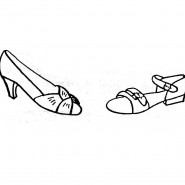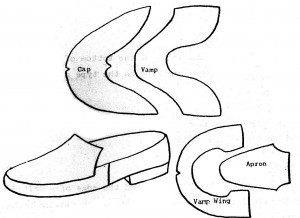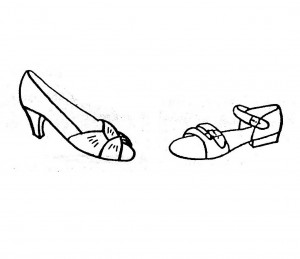
VAMPS
May consist of a single niece of upper material, or two separate pieces stitched together to make a whole. Example:
- Toecaps and Wing caps:
Straight toecap is set squarely across the shoe. Wingcap is angled back the toecap and vamp both extend to the lasting edge.
- Aprons and vamp wings:
The vamp may be divided into an apron covering part of the top of the foot with wings enclosing the aides. Only the wings extend to the lasting edge.
- Tongues and tabs:
The tongue may be separate or the vamp and tongue in one piece. An apron vamp may have a separate tab to cover the instep or apron and tab may be one piece.
- Peep-toes:
The toe is left open and this consists of a single strap or a series of interlaced straps.
- BACK STAPS:
The heel seam is often reinforced with a counter or back strap.
- FASTENINGS:
- a) Court shoes:
The court shoe has no adjustable means of securing and relies on exact fit at the joint and heel to keep it secure. (Topline clip)
- b) Walking shoes:
Rely on support from the instep as they are less curved at the back than high heeled shoes. The topline should be sufficiently loose to allow easy entry to the foot, but tight enough to be secure in walking.
This is done by:
- Using elastic in the topline (gusset)
- Laces
- Buckles
- c) Ankle Boots:
Elastic gussets, laces or zips to allow easy entry for the foot.
- d) Mules:
Held on only by the vamp.
LINING:
1) Counter Linings: Inserted at the back of the shoe to cover the stiffener or to help grip the back of the foot.
2) Quarter and full linings: More expensive shoes have a quarter lining extended to the facings or a full lining for vamp and quarters.
3) Backers: Used to reinforce or add substance to certain parts of the shoe. Usually bonded and may also be stitched




